It was long after midnight but Saturday’s morning skies had turned as gloomy as the forecast had indicated they would. The predicted rain had yet to start and since several weather forecasts in Lisbon had been generally as inaccurate as they often are in the DMV, I had some hope that I could at least get to Lisbon’s famous flea market Feira da Ladra in the Campo de Santa Clara and back to the flat before the skies opened. I was curious not only about the quite well-known market but also to see the change in the Campo since on an ordinary Thursday, it looks rather like this:.
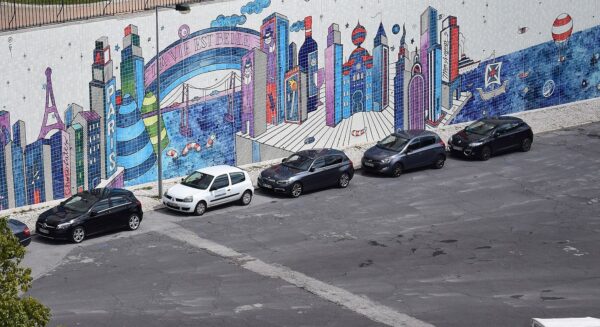
I was less optimistic about the prospect of going on a second art exploration to the Underdogs Gallery.
At this point, I sent a message to Ana telling her that I was concerned about the rain and the distance of walking to both. The casual nature of her reply that I should go to the flea market in the morning then take a bus from Praça Restauradores to Marvila that would get me there “in no time” was yet one more element that would have an interesting impact in a few days.
Another etymological detour.
Here’s an interesting experiment to try with Google Translate. Ask it to translate “feira da ladra” from Portuguese to English and it returns the answer “flea market.” Now click on (or tap) the directional arrows that will swap the phrases. The English remains “flea market” but the Portuguese becomes the more literal “mercado de pulgas”.
(In fact, most language historians believe that the English term flea market was itself a literal translation from the French “marché aux puces”. {You might notice connections between marché and mercado and between puces and pulgas.} This was the moniker attached to a Parisian market that sold second-hand goods. Mattresses and clothing sold there might or might not have been infested with fleas or other insects.)
If you enter the words feira and ladra individually, Google will translate them as fair and thief – with ladra more precisely being a female thief. So how might this “flea market” have come to be called the Thieves Market? In my limited research, I could find nothing beyond the assertion made on some official Lisbon tourist websites that the word ladra “actually derives from ‘ladro,’ a bug or a flea found in antiques”. This seems to me to be the ultimate in spin. I could find no online dictionary that translated ladro as anything but thief. Further, Wiktionary describes its etymology as being “From Old Portuguese ladron, from Latin latrōnem, accusative of latrō (“highwayman, brigand”)” and given seven centuries of Roman rule, it makes sense that ladro – in whatever contemporary form – has always meant thief.
Amuse yourselves for a few moments with some wall art I passed on my walk to the market while I engage in some speculation regarding the origin of the market’s appellation.
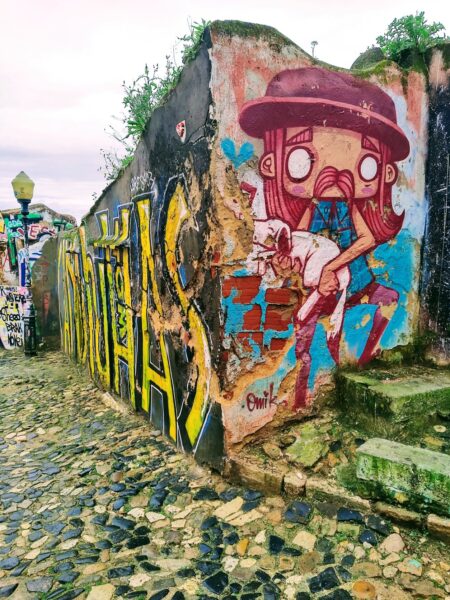
Although the term Feira da Ladra first appeared in the 17th century, a market of this type has existed in Lisboa since 1272. It was first located near the castle gate along the rua do Chão da Feira. This makes apparent why this would hold the word feira in its name although it was then known as the Mercado Franco de Lisboa.
Sometime in the 16th century, it relocated to Praça do Rossio. (It’s first noted there officially in 1552.) After the 1755 earthquake, the market moved again this time to Praça da Alegria. It moved again in 1835 to Campo dos Mártires da Pátria and found its current home at the Campo de Santa Clara in 1882. You can follow its progression in this screen capture from Google Maps with the end of its path marked by the red pin.
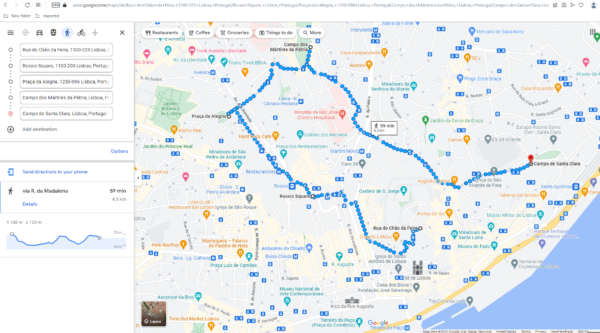
The key to my speculation stems from its original name, Mercado Franco. This loosely translates to Honest Market. (Think of the relationship between the Portuguese franco and the English frank.) It doesn’t require much imagination to envision the sort of cheating or even actual theft that might have happened in such an unregulated environment. Neither is it hard to conceive that people began saying something along the lines of, “Mercado Franco! Mais como um Mecado ladrões!” (“Honest market! More like a Thieves Market!”) And the latter became the common usage. But, as I noted, this is nothing more than my speculation.
Walking in the Rain.
I didn’t pack an umbrella but Sérgio had two outside the flat and, although it hadn’t started to rain when I left the flat, the skies and the forecast indicated that prudence dictate I carry one with me. While the walk up the hill was moderately steep, the Campo do Santa Clara was just a bit more than 1,500 meters from the flat and when I reached the market, the clouds still held the rain in abeyance. Once I passed under the Arco Grande de Cima, I got my first glimpse of the Feira da Ladra.
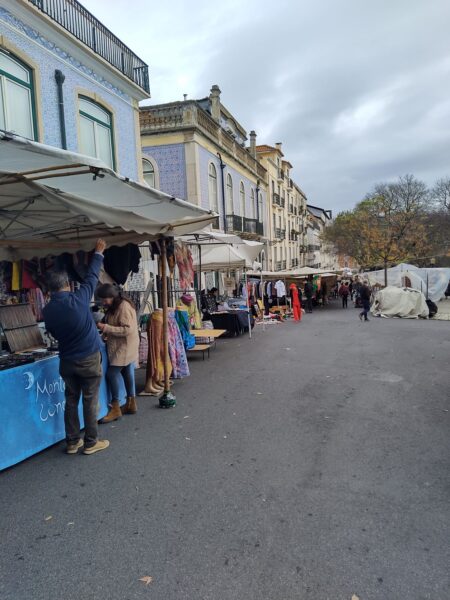
This is a very small section of the breadth of this flea market. Rita Alves on the website AFAR posts this description:
This is a great opportunity to get a dose of local flavor as you mingle with the residents buying and selling their wares on Campo de Santa Clara. Anything from broken-in shoes to axe body spray, x-rated videos to classic vinyl records, vintage soda cans to childrens (sic) books, you’ll be sure to find something unique and even useful to bring back home with you. Not overrun with the tourist trade yet, jump in and put your Portuguese to practice as you bargain with the vendors – simple knowledge of numbers will go a long way to get a good price.
Although I made two purchases, I’ll come clean and admit that I didn’t put my “Portuguese to practice” and bargain with the vendors for a few reasons. First, my Portuguese isn’t that good yet. Second, it was near the end of the trip and I was as interested in spending down my euros as I was in trying to save a euro or two by bargaining. Third, I was happy with the prices I paid – €8 for a hand made leather belt and €4 for a cloth tote bag with a Lisboa tram ironed on the front.
Just after I bought the belt, the promised rain arrived and many of the vendors had to quickly cover their wares with plastic sheeting. I took that as my cue to head back to the apartment. It started to rain quite hard for awhile and I stepped in a puddle deep enough to render my waterproof shoes useless as the water splashed above my shoe tops. I did manage to snap this photo on the way.
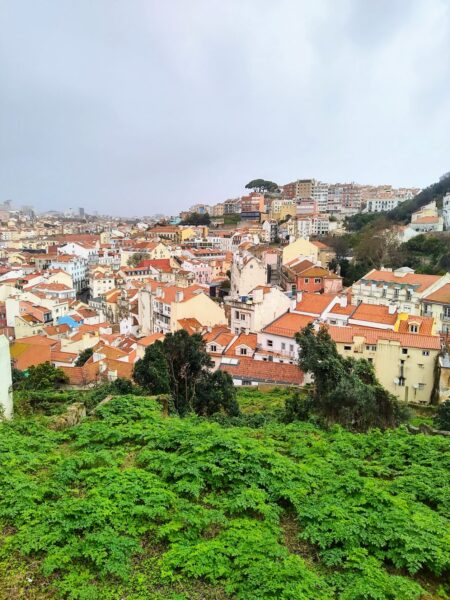
The rain did, in fact, persist throughout the day so, despite Ana’s useful suggestion, I changed into my pajamas and remained at home until dinner. Fortunately, there was a well reviewed Italian restaurant within steps of my front door. The meal was fine with a couvert of bread and olives, grilled salmon with potatoes and vegetables in a pesto sauce, and a glass or two of port to finish the meal. At €40, it was by far the most expensive meal of the trip and, at this price, not one I’d recommend. But by nightfall, the rain had abated and I was able to squeeze in a nice walk after dinner.
Really enjoying these posts! The musical references are great, too! I think I’ve found almost everything you’ve hidden, and probably a few extras as well!
I’m looking forward to seeing what you’ve found.